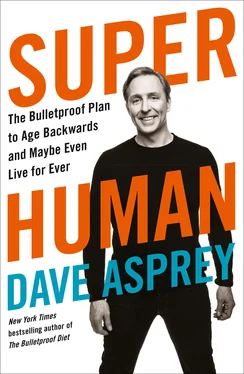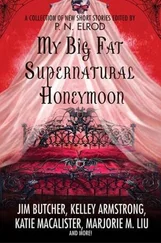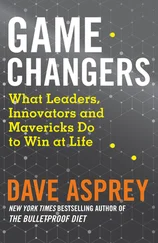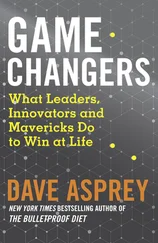1 ...7 8 9 11 12 13 ...20 • To help with cardiovascular issues, try the Zona Plus, a digitally controlled handheld device that uses the science behind isometric exercise to increase both vascular flexibility (thus decreasing blood pressure) and the production and flow of nitric oxide throughout the body, which is linked to treating various cardiovascular conditions, erectile dysfunction, and muscle fatigue. It’s a cool biohack for anyone who wants to improve their cardiovascular health.
• While it is most useful to look at how the environment will control your energy levels and your aging, it’s not like your DNA is meaningless. The area of functional genomics is just getting going. Like functional medicine, it is the study of what you can actually do to influence risk besides worry about it. For instance, a functional review of my genome from the DNA Company revealed that I should take extra steps to take care of the tight membranes in my arteries, including taking the supplements in this book. Check out their tests to discover your weaknesses and learn how to combat them.
2
THE SEVEN PILLARS OF AGING
Okay, now you’ve decided not to let the Four Killers take you out. That means it’s time to shore up the Seven Pillars of Aging. When I was working to reverse my early aging as a young man, I learned that there are specific forms of cellular aging that drive all forms of aging and disease, even my premature symptoms of aging. Later, I gleaned more detail from longevity experts such as Aubrey de Grey, who is the chief science officer at the SENS (Strategies for Engineered Negligible Senescence) Research Foundation, which has the ambitious mission of curing aging by funding anti-aging research around the world. A lot of my elite anti-aging longevity friends (yes, I have weird and awesome friends) are focused on what SENS calls the “classes of cellular and molecular damage that constitute aging.” I call them the Seven Pillars of Aging.
THE SEVEN PILLARS OF AGING
It’s important to understand how the Seven Pillars of Aging affect your body on the cellular level. While some degeneration over time is a given, there’s a lot you can do to protect yourself from the worst of it. From simple and inexpensive lifestyle changes and nutritional modifications to high-end technologies that are rapidly becoming more affordable, I’ll outline multiple strategies to hack the aging process—most of which I’ve tried out myself.
Is this anti-aging science still nascent? Yes. Do we have ironclad evidence that these strategies work perfectly? No. But we do have some pretty compelling research that suggests they will help you spend more quality years on this planet. Plus, they’re not going to kill you—and aging definitely will. So why not give them a shot?
First, let’s take a closer look at each of the aging pathways and how they affect us.
PILLAR 1—SHRINKING TISSUES
When you are young, your body has a multitude of stem cells—undifferentiated cells that are capable of giving rise to many more cells of the same type. When cells die via apoptosis, your stem cells spring into action to replace them. As you age, however, a few things happen. Your stem cell reserves dwindle, your stem cells themselves age and thus become less efficient at replacing dead cells, and your mitochondria may not trigger apoptosis at the right times. Some cells die before they’re supposed to. Others aren’t quickly replaced. As a result, tissues throughout your body lose more and more cells and begin to atrophy, or break down.
Quick, picture a stereotypical “old person.” In your mind’s eye you probably see a frail person with loose skin, no muscle tone, shaky hands, and a foggy memory—right? The truth is that these things happen as we age and cells die and are not replaced. In fact, loss of muscle tissue is so common that it has its own name, sarcopenia , a condition that can lead to falls and broken bones and even impairs the body from fully recovering after those tumbles (or a surgery). 1In most people, sarcopenia sets in as early as age thirty and gets worse with each passing decade. 2
When neurons in the brain die and your body isn’t able to replace them, your brain literally shrinks. And yes, this typically happens as we age. This contributes to cognitive decline and dementia, as well as a decrease in fine motor skills. In particular, when that neuron loss takes place in the hippocampus—the part of the brain that controls emotion, memory, and the nervous system—you begin to look and sound a lot like that old person you just imagined. Since hippocampal atrophy is so common, the size of your hippocampus is considered a key marker of aging. 3But there is nothing normal about it—at least, there shouldn’t be.
So the big question becomes, What can you do to make sure those dead cells get replaced (or don’t die in the first place)?
It turns out that if you keep your mitochondria healthy, you can avoid a lot of unnecessary cell loss. The biggest game changer here is eating foods that boost the efficiency of your mitochondria so they can make more energy and your body has the raw goods it needs to manufacture all the proteins, hormones, and fatty acids they require to function. We’ll cover those foods in the next chapter.
It is possible to reverse atrophy by taking advantage of stem cell therapy—a medical treatment in which stem cells are injected into your body. I’ve had more stem cell treatments than probably anyone on Earth (more on this later), and it’s been a game changer for me. I went from having chemical-toxin-induced brain damage as a young man to having a hippocampal volume that’s in the 87th percentile for someone my age. But stem cell therapy does not come cheaply or easily, so it’s better to prevent atrophy in the first place!
The key to success with any of these interventions is to start them now, even if you don’t think you need them. After all, humans are good at avoiding things that hurt. You don’t step on nails or burn yourself because you feel the impact of those cuts immediately. But when it comes to aging, you’re the proverbial frog in a pot of slowly heating water. You keep taking the hits because you don’t feel the impact right away. But cutting down on just a few of those hits by making small changes in your environment can really ramp up what’s possible for you. Perfection not required.
PILLAR 2—MITOCHONDRIAL MUTATIONS
Mitochondrial mutations—aka damaged mitochondria—are the second pillar of aging. The importance of this aging pathway cannot be overstated. When the power plants of your cells—the very things that create the energy that keeps you alive—start mutating, is it any wonder everything goes haywire?
Unfortunately, this is a cause of aging that is often overlooked. Even those on the forefront of biotechnology have been so focused over the past several decades on mapping the human genome that they have paid little attention to mutations in mitochondrial DNA. Don’t get me wrong—the sequencing of the human genome changed the world, and I’m grateful for the scientists who accomplished this monumental task. But unless you have a significant genetic disorder, it turns out that the human genome is not usually of great value in predicting how you’ll age compared to your mitochondrial DNA status.
You can think of your genetic code as the building plans for your body—but who wants a body that doesn’t have any energy? (Hint: That’s called death.) Remember, your mitochondrial genome is separate from your human genome—mitochondria evolved from bacteria and have their own genetic code. But your mitochondrial DNA serves a very important function—it controls how your body makes energy. Unfortunately, your mitochondrial DNA is a lot more susceptible to mutations than your human DNA because mitochondrial DNA has a limited ability to repair itself when it is damaged. So you’re going to want to take fewer hits to your mitochondria.
Читать дальше






